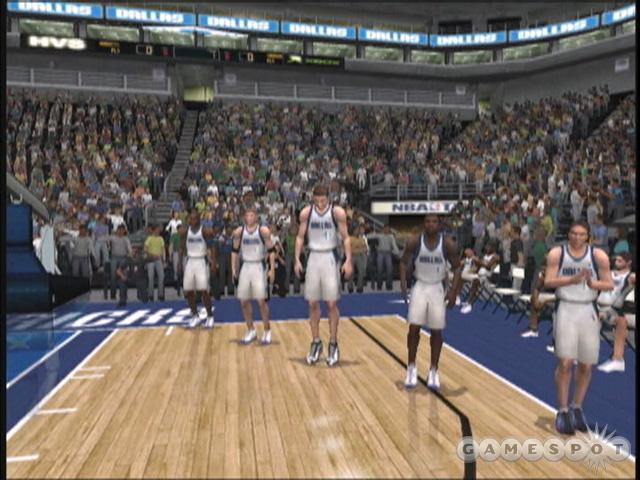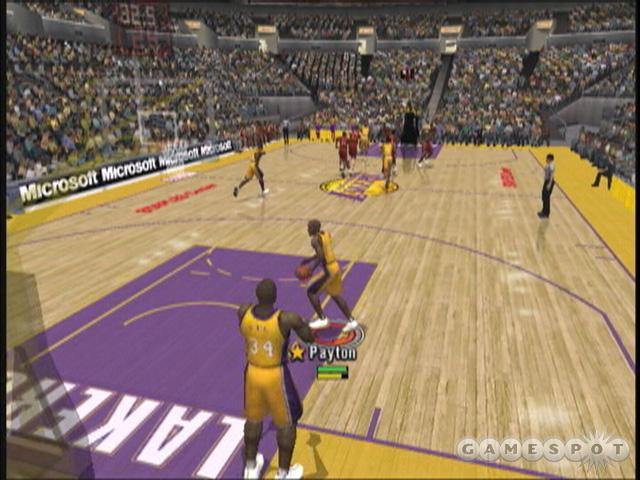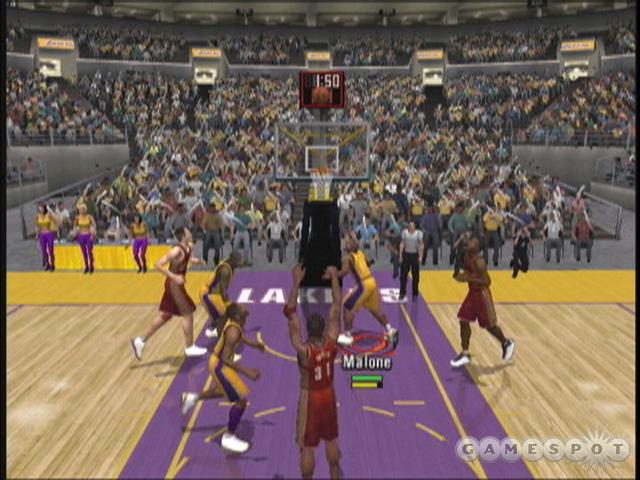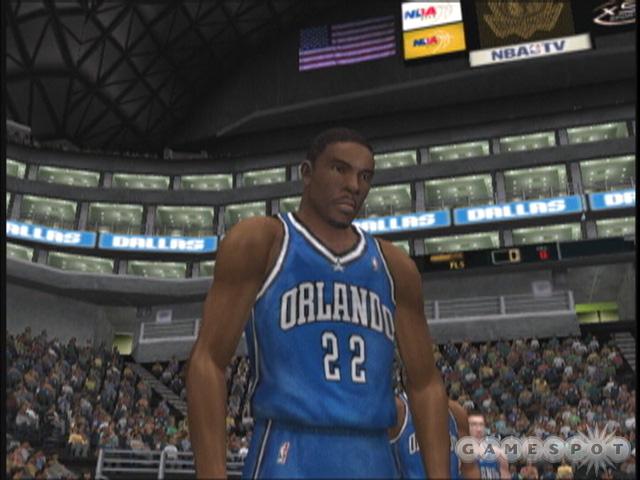With the recent release of NBA Inside Drive 2004, Microsoft is the last of the major sports game publishers to bring its sim-style basketball game to market. The Inside Drive series is relatively young, having gotten its start in 1999 with Inside Drive 2000 for the PC. The series continued on the Xbox in 2002 and has diligently worked to make headway against heavyweight competition from EA and Sega Sports. With each iteration, the series has offered more and more features, but with Inside Drive 2004, it's apparent that the developers at High Voltage still have a ways to go before catching up to their competitors.

The first thing you'll notice about NBA Inside Drive 2004 is its lackluster presentation. It's clearly not a game that stretches the Xbox's graphical capabilities to their fullest extent. On the plus side, the player models exhibit a fair amount of detail, and the arena representations are pretty accurate overall. Most of the dunk animations look decent. Aside from these, the game's animations are generally stiff and robotic. This is most apparent when viewing players who are running up the court without the ball. Players backing down in the post appear to be moving on their tiptoes instead of banging convincingly against defenders for position. When your player takes the ball from the referee for a free throw, his hands look more like oven mitts than real hands with fingers that clasp the ball. The artists didn't seem to do a great job at modeling the faces of the various NBA players either. Though most of the stars look reasonably close, some of the mid- to low-level players look almost completely generic in their representations. Even the edges of player models and the lines on the court don't look very clean compared to other Xbox games.
Inside Drive 2004's sound is nothing special either. The music used during the menu screens consists of poorly produced hip-hop tunes with the artists rapping primarily about the Xbox and the game. While playing a game, the crowd seems almost lifeless. It doesn't seem to matter if the home team is winning big or losing big, as the crowd noise is represented by a, more or less, generic and constant buzz that could easily be mistaken for a synthesized ocean tide. At the very least, you can hear players chattering with one another, and you can hear the ball bouncing off of the floor and coming off of the rim. The on-court sound effects are decent overall and get the job done.
Play-by-play and color duties are handled by a trio of announcers that includes Kevin Calabro, Marques Johnson, and Kenny Smith. Smith, known as an NBA analyst on TNT's broadcasts, is clearly the best of the three, but that's not saying much. Anyone who's watched a lot of Pac-10 college basketball games on Fox knows that Marques Johnson is one of the worst in the business. Those who aren't familiar with him need only hear comments like "That's what I call the Obi-Wan offense; the Force was with him, so he forced up the shot!" to know how he earned his reputation. Calabro is a little overexcitable and sounds much like a middle-aged man trying to be hip--but he fails miserably. He refers to jump shots as "jimmies" and offers up other gems like, "It's round and orange, but it's still a brick." The game also contains a few attempts at jokes via the in-game PA announcer. You'll hear things like, "Will the owner of the pitifully old Swedish station wagon please report. Your car has been designated a superfund cleanup site." It's almost as if they're trying to deflect attention away from the actual game.

Another disappointing aspect about the game is that its default rosters are extremely old. In fact, they date back to September 15 (thankfully, of 2003). A game that comes out over a month after its competitors should definitely have the most updated rosters and ratings. There was more than an ample opportunity to include recent major trades, like the recent October transaction involving forward Antoine Walker's move from the Boston Celtics to the Dallas Mavericks. Additionally, ratings could have been increased to reflect the amazing real-world skills of the Cleveland Cavalier's phenom LeBron James or the superior play of Seattle SuperSonics sensation Ronald "Flip" Murray. Instead, we see that Dikembe Mutombo is still on the New Jersey Nets, and many other players who switched teams even before the preseason are on the wrong squads. It's inexcusable that Inside Drive 2004 should have the oldest roster set of all the NBA games. Obviously, those with Xbox Live can download updated rosters, but, as of this writing, no new rosters were available. This might not be so bad if the included ratings were accurate, but there are a number of notable errors, like the fact that Reece Gaines (who hardly gets off the bench in real life) starts for the Orlando Magic and journeyman point guard Rafer Alston is rated higher in ability than both Nick Van Exel and Andre Miller. Dunk ratings seem a little unrealistic too, as you'll see diminutive guards like Stephon Marbury and Darrell Armstrong throwing down two-hand tomahawk dunks in traffic.
On the positive side, Inside Drive's gameplay is good overall, but it's not great. The two major things the game has handled well are the passing and the play-calling. Passing is very crisp. For the most part; the ball leaves players' hands very quickly and with little time wasted for windups, which is what you'd expect from pro basketball players. There's a separate button for lob passes, which is useful for feeding the post, and you can also execute quick, touch passes by double-tapping the button.
The play-calling in Inside Drive 2004 is arguably the best of all the basketball games. You can examine and choose from several sets of offensive plays in the playbook, and you can access four at a time, during the game, from the D pad. They generally work very well at creating open shots. Seeing all the players running into their correct positions and executing their cuts and screens is fun. It's even more satisfying to hit a slasher on his way to the basket or finding the open jump-shooter coming off of a curl. On the defensive side, there aren't really any set plays, but you can still adjust the level of pressure you place on the ball, tweak how the AI handles off switches, and choose man or zone defenses.
The problem with all of this is that it isn't necessary to call plays. NBA Inside Drive 2004 has three difficulty ratings: rookie, veteran, and all-star. The first two levels are laughably easy, and even all-star difficulty shouldn't pose too much of a challenge for seasoned basketball sim players. By taking any star player or fast wing player, you can very easily work your way to the basket just by dribbling back and forth across the court while trying to get your man caught up in a pile of bodies. The problem isn't as pronounced as in 989's PS2 train wreck, NBA ShootOut, but it's there nonetheless. Without calling any plays, without performing any juke moves, and by executing a minimal amount of passing, you can easily work yourself into the paint for a close shot or an easy dunk. At most, you'll just need to call for a pick to shake your man, but the screener usually won't set up in the proper spot anyway.

Actually, you should be able to work a dunk on almost every single possession. However, the game's dunk radius does seem rather narrow--especially in traffic. Even if you have a high-flier like Kevin Garnett, with no one but a guard between him and the basket, you'll see him take a weak, short jumper. We've experienced numerous occasions where our player wouldn't dunk, even with his feet right on top of the painted circle under the basket. These jumpers have a much higher chance of rimming out than a layup or dunk. Still, at the default six-minute quarter settings, we didn't have a problem breaking 100 or 110 points in most games.
Defense is a bit of an adventure. At the highest difficulty levels, the computer will find open outside shots with disturbing frequency. The problem is that your teammates often get lost as they try to keep up with players who are moving without the ball. Often, by the time you switch over to the lost player--to fix things--his assigned man is wide open and is going up with the shot. You can obviously reduce their chances by jumping at the shooter, but at the default settings, the referees in Inside Drive 2004 will call a ton of fouls. The sensitivity is set to a point where you're almost afraid to jump at shooters because you'll hardly get any blocks--unless you have absolutely perfect position and you time the jump perfectly. More often than not, you'll get whistled for the hack, and you'll send the computer to the line for a couple of free throws or a three-point play opportunity.
The computer will foul you often as well, as it is very aggressive with reach-ins and is a little bit too successful at them. At the higher difficulty levels, don't be surprised to see lumbering centers and power forwards tapping the ball out of the hands of slick guards like Tracy McGrady or Steve Nash. You'll get fouled often though, and, subsequently, you'll get sent to the line for plenty of free throws. Between your team and the computer, it's not uncommon to have about one foul whistled per minute of play, which can make games at the default six-minute quarter setting painfully slow. It might not be quite as bad if the free throw mechanic was interesting, but it's basically the same as an early video game golf swing. You press a button to start a meter on the "upswing," and you press it again to stop the meter on the free-throw-power target to begin the "downswing." Press the button a third time to stop the meter on the accuracy target. Anyone who's played a golf game within the past 10 years or so shouldn't have a problem achieving at least a 90 percent accuracy rating on free throws.

The franchise mode in Inside Drive 2004 is very basic. You play up to 25 seasons, simulating or playing the games as you wish. You're able to propose trades and receive proposals from the computer. You need to deal with injuries (which occur fairly often over the course of a season) and a hard point cap that doesn't seem to take into account the NBA's "Larry Bird rule" that allows a team to exceed its salary cap to re-sign its own player(s). You can't set team tendencies, substitution patterns, or anything specific in nature while simulating your games. The off-season draft is bare bones as well. No player scouting is done. You simply choose your rookie off the menu, where it gives you exact player ratings. There's absolutely no mystery about what you're getting. The only interesting twist is that you can create a player and add him to a team. You can assign skill points to that player to customize him, and more points can be earned by playing him in games and by completing certain challenges with him.
Online play is available over Xbox Live, and Inside Drive 2004 is also supported by XSN service. Using the XSN sports Web site, you're able to check up on your stats, find tournaments, and interact with other players via message boards. The only strange thing we noticed about the interface is that we couldn't find the leaderboard, either in the game or on the XSN Web site. We've had mixed experiences while playing the game online. Most of the matches we played at home, over a cable modem connection, were marred by network latency issues, causing the game to be slow and unresponsive. The matches we played at the office, over a much faster connection were obviously much smoother. Your own experience may vary. It's still early, so there may be some growing pains involved as Microsoft brings all the XSN features together.
If the developers had only included a stiffer defensive AI--and one that didn't rely so much on reach-ins and steals--NBA Inside Drive 2004 might have turned out to be a pretty good game, even with its lackluster presentation. As it stands, the uneven gameplay, ho-hum visuals, and shallow franchise mode leave the game with very little to help it stand out from the competition. The bottom line is that there are better choices than NBA Inside Drive 2004, unless you're dead-set on having XSN-enabled features.